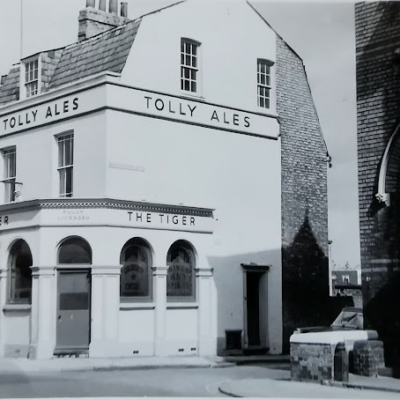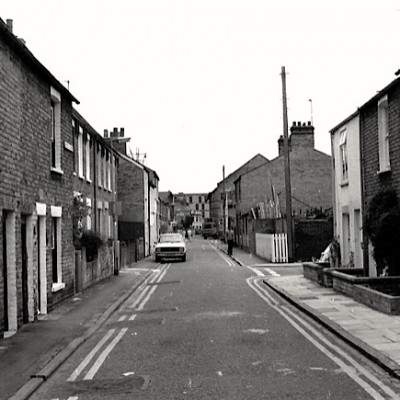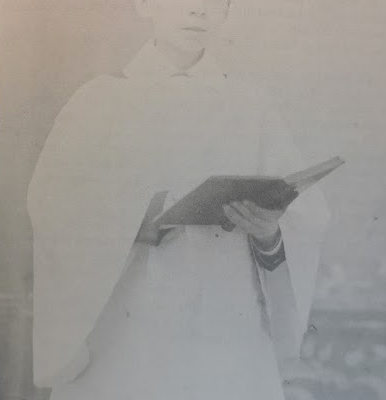Search by topic
- archaeology
- Building of Local Interest
- chapel
- charity
- church
- crime
- dressmaker
- fire
- Great Eastern Railway
- Listed building
- Mapping Relief
- medieval
- oral history
- poverty
- Public House
- Religious House
- Roman
- scholar
- school
- Then and Now
- tudor
- women
- work
- world war one
- world war two
Search by text

The Six Bells, Covent Garden, Cambridge
The Six Bells public house has stood on Covent Garden since at least 1838, probably a lot longer. In that year, its owner was Francis Eaden.
Publicans at The Six Bells
Francis was perhaps a member of the family that owned the haberdashery store Eaden Lilley, which goes back to the 18th century, and stood on Market Street until its closure in 1999. Several members of the Eaden and Lilley families are buried in Histon Road and Ascension Cemeteries, and several Eadens in Mill Road Cemetery. One grave in Mill Road records a Francis John Eaden, ‛accidentally killed’ in 1849 aged 13, who was the ‛son of Francis and Anne Eaden ’ ‒ Was his father the owner of the Six Bells?
Israel and Sarah Haggis
The publican of the Six Bells in that same year (1838) went by the delightful name of Israel Haggis!
Many people with the surname Haggis can be found buried in Mill Road Cemetery, but alas no Israel Haggis appears in any Cambridge cemetery.
In 1841, Israel Haggis, aged 25, was still living and working at the pub, with his wife Sarah, aged 20, maidservant Mary Bell and manservant James Langley. Israel and Sarah (née Hankin) had been married in 1836. But in 1843 Sarah eloped. The story is recounted in a fascinating Cambridge newspaper report of 9 December:
One Alfred Hutt, who had been Israel Haggis’s manservant for eight years, was on trial for stealing property (two cricket bats, two balls, a pair of cricket shoes, clothes and other articles) from Israel. In early November, Israel had gone to a lodging house in Hammersmith to challenge Hutt, and had found his own wife (Sarah) and her sister in bed there, and Hutt in the room, along with his property. Hutt and Sarah were going under the names ‛Mr. and Mrs. Hales’. Before the magistrates, Sarah was called as a witness:
This witness, who from her manner of entering the Court appeared to be slightly intoxicated, said that she had left her husband … on the 6th of October last, and that she had sent the property … to the house at Hammersmith.
When shown a letter in her hand addressed ‛Dear Alfred’, she ‛impudently refused’ to say whether that referred to Hutt, but later remarked:
I never was so happy in my life before, dear Alfred is so kind to me.
The case was committed to trial at the next quarter sessions, and the newpaper reported this on 6 January 1844. In the course of the trial, Haggis stated: ‛my wife, I am sorry to say, has not, for the last three years, been of sober habits’. The jury was not convinced that Alfred Hutt had stolen the goods alleged, and brought in a verdict of Not Guilty.
By the date of that trial, Israel Haggis had already left the Six Bells and was running the New Inn on Parker’s piece. Three months later he placed an advertisement in the local newspaper announcing that he had for sale an assortment of cricket bats:
of the lightest and best-seasoned wood, made by the most eminent makers, viz. Cobbett, Caldecourt, and Dark, (which are not to be equalled in this country)
and other cricket equipment, including:
balls; newly-invented light cork Leg Pads, and Finger Guards, of all sizes; Stumps; Bails; Scoring Papers; the Laws of the Game of Cricket, &c.
Remembering that cricket equipment was alleged to have been stolen from the Six Bells, it seems that Israel had a long-standing involvement with cricket—perhaps the cricket played on Parker’s Piece by such notables as Robert Carpenter and Tom Hayward, both of whom played for England. Israel died in 1849. It would be interesting to know what happened to Sarah in the years after the break-up, and also to Francis Eaden, who was succeeded as owner of the Six Bells in the mid-1860s by John Eaden (perhaps his son).
John Pledger’s beer-shop
Israel wasn’t the only publican on Covent Garden in 1841. Joseph Pledger owned the garden opposite the Six Bells and also ran a ‛beer-shop’. A slightly earlier newspaper report (14 August 1841) records:
Jabez How (27), fined 2s. 6d., and expenses, for assaulting I. Haggis, at Mr. Pledger’s beer-shop, in Covent Garden; also fined 10s., and expenses, for assaulting Mrs. Haggis, at the Six Bells.
Covent Garden was evidently a riotous place in those days!
(Sources: articles in the Cambridge Independent Press found by Allan Brigham.)
In 2024 JM sent this note:
As New Year approaches, I recall the celebrations at the Six Bells when I was in my late teens and early twenties. The first New Year recollection that emerges is that that was the time when Olive visited her parents, who ran the place. She was a very lively lady and great fun. We had a small but very lively New Year in the front bar. For a few years, I was a regular. My memory tells me that the Landlady and Landlord were Em and Harry (can anybody confirm that?). I always felt particularly privileged that Em would begin pouring my pint of Greene King bitter as I walked in the door. What a welcome. There were several other regulars including my school friend Bill Butcher, whose one-armed dad HW Butcher had the sweet shop at 14 Mill Road. A rare character was Black John, called that with affection and acceptance, not as any sort of insult. Like the rest of us, he was a darts player, completely accepted until we were joined by a young South African who had the greatest difficulty competing as an equal with John. He couldn’t understand how he was integrated so completely in our company. Back home such people were lowly servants (Boy!) … in the 1960s! This small Six Bells community continued until Em and Harry retired to the Steward & Patteson rest home in Norwich and we variously pursued our different lives.
Contribute
Do you have any information about the people or places in this article? If so, then please let us know using the Contact page or by emailing capturingcambridge@
License
This work is licensed under CC BY-NC-SA 4.0











